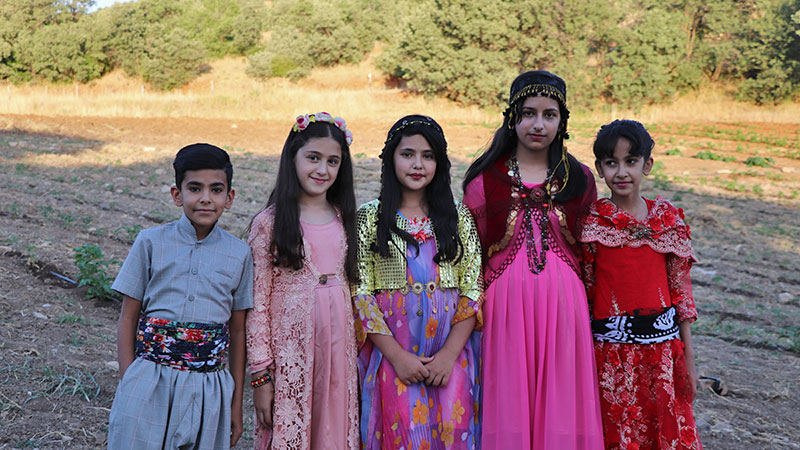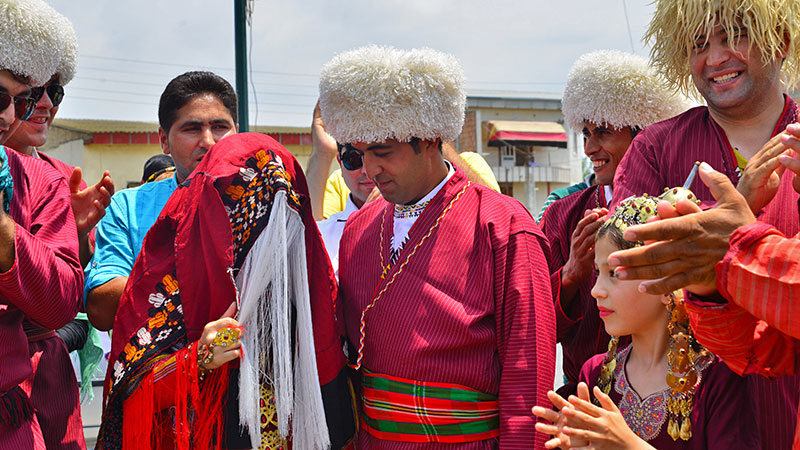 Signin with Google
Signin with Google Signin with Facebook
Signin with Facebook About Iran
About IranIran's Ethnic Groups

Iran is a multicultural country where original ethnic and linguistic diversity is one of its attractive features. This ethnic and linguistic diversity stems from Iran's rich history and Iranian border pattern that has changed many times over the centuries.
Different ethnic groups are one of the boldest beauties of Iran as it mixes different cultures and put them all together in a united country. Political borders have separated most ethnic groups from their first race. The largest groups in this category include the Persians or Fars group (the majority of Iran's population) and Turks, Kurds, Gilakis, Mazanis, Lurs, Turkmens, Arabs, Talyshis, Balochs and many more. Following up we aim to introduce the main ethnic groups of Iran.
1- Persian (Fars)
Iranian Persians, who make up the majority of Iran's population, dominate the people of Iran mostly in the central country. Iran used to be called "Persia" until 1935 that officially changed its name to Iran. Persians live in major provinces in Iran such as Tehran, Isfahan, Mashhad, Kerman, Yazd, and Fars. Also, at least half of the populations in the bilingual cities of Kermanshah, Ahvaz, and Zahedan are Persian.
Persians speak Farsi or Persian as Iran's official language in different accents. Persian is a West Iranian type of Indo-European family of languages; however, there are many different accents or vocal expressions that Fars folks speak. Most Persians are Shia Muslims.
2- Azeri or Iranian Turk
Regarding the origin of Iranian Turks, there are two opinions. The first one says the Turk race has come to the Iranian Plateau in the 7th and 11th centuries during the invasion of Iran. The second one declares they are original inhabitants of Iran on whom the invaders have imposed their languages throughout wars and occupation.
The Turkish language spoken in Iran is correlated with the Turkish spoken in the Caucasus, but it has changed in various regions. The Turks are the largest non-Farsi-speaking ethnic group in Iran. Maybe that is because several Turkish dynasties have ruled over Iran in the past centuries, Including the Ilkhanids, Timurids, Ghaznavids, Seljuks, Safavids, and Qajars.
The leadership of Iran's national-political movements, especially in the Persian Constitutional Revolution 1905- 1911, is one of the most important actions of Iranian Turks in Iran's history. Their principal role was in organising the constitutional movement. Also, continuing the armed resistance in Tabriz city, led by the famous commanders, Sattar Khan and Baqir Khan, led to the capture of Tehran. This national action, following previous political records, implies their patriotic tendency and nationalism. This movement can be said to be the beginning of the establishment of a national government in Iran.
Mostly, Iranian Turks live in the northwest of Iran. However, they are scattered throughout many other cities.

3- Kurd
The Kurds reside mainly in the Kurdistan region. But the dispersion of the Kurd race in Iran is in Kurdistan, Kermanshah, Ilam, North Khorasan and West Azerbaijan. It is a vast region extending to a major part of the Zagros Mountains area. Including southeast Turkey, northeast Iraq, northwest Iran and parts of Russia, as well as Syria.
The origin of the Kurds backs to Medes, and they claim to be the oldest Iranian people in the region. Ferdowsi, the author of Shahnameh, Book of Kings, believed the Kurd tribe is the descendant of surviving Iranians from the tyranny of Zahhak or Azhi Dehak, an evil figure in Persian mythology. The Kurds' origin backs to the Iranian race. The Kurdish language is a subset of the Iranian languages' western branch that owns different dialects.
Several Kurdish clans are inhabiting Iran. The notable ones are Major Jalali in northwest Azerbaijan, Kalhor and Gouran in Kermanshah and Malek Shahi in Ilam Province. Kurd's religion is commonly Shafi Sunnis, and some are Ahl-e Haq or Yaresan sects. Still, Qaderi and Naqshbandi types of Sufism are also common in some parts of the Kermanshah. The Kurds' residence in northeastern Iran is mainly Shia Muslims.
The Kurdish population in Iran is estimated to be around 7 million. But the Kurdish community are more than 20 million.

4- Baluch
Balochs are among the Iranian ethnic groups generally occupy in the southeast and the eastern of Iran in Sistan and Baluchistan province, which is the second-largest province of the country.
But formally the southern parts of this province form Balochistan. A vast portion of Balochistan parted from Iran in Qajar time over British colonialism. Thus the Iranian Baluchistan is stretched alongside the Makran Sear or Oman Sea which has got direct way toward free international waters. Balochistan has exceptional historical, mythical and natural backgrounds and 1000 years ago, Ferdowsi, the great poet of Iran mentioned the Baloch clan in Shahnameh and named them as a part of the Persian army.
Ernst Emil Herzfeld, a German archaeologist who excavated Persepolis and Pasargadae believes the word Baloch comes from a Medes term that means "a loud shout". But some others say Baloch is a combination of two words; Bal means hero and Ouch which means tall in Avesta, a collection of Zoroastrian religious texts, that together Bal and Ouch indicate a lofty hero.
Balochs are broadly inhabited in the southern lands of Balochistan that call Makran, then South Khorasan Province, Razavi Khorasan Province as well as some regions in Hormuzgan and Kerman Province. Also, a group of Balochs migrated to Golestan Province and Turkmen Sahra regions due to the hard drought several years ago.
Balochs of Iran follow Hanafi Sunni Islam. Balochi language is categorised as the western branch of Iranian languages that consists of two substations; the southern branch is named Makourani, and the northern one calls Sar-Hadi. The prominent Baloch tribes are Rigi, Shah-Bakhsh and Shah Navazi.

5- Arab
The first historical signs of Arabs' presence in Iran date back to the 3rd century at the time of the Sassanian Empire. In a region between today Iraq, Saudi Arabia and Iran, lived an Arab clan named Lakhmi. Lakhmis were considered Iranian citizens, and always have been a part of the Iranian army in The Roman-Persian wars. Ultimately, this barrier between Iran and the Arabian Peninsula broke, and the Persian Empire came to an end with the Muslim conquest of the Persians. Like the other tribes, Arabs are an inseparable part of the tribal body of Iran. Today only a few groups of Arabs from the Khamseh tribe follow the nomadic lifestyle in Iran and have seasonal migration to Fars Province.
Arabs of Iran have three distribution in Iran:
- Arabs of Khuzestan
- The Khamseh Arabs in Fars
- Arabs of Khorasan

The Arabs of Khuzestan country are divided into different tribes. One of the largest of them is the Bani-Kaab tribe inhabits Khorramshahr, Shadegan on both sides of the Karun River. According to the geographical district, Arabs of Khuzestan locates in two categories. Kamari Arabs of Khuzestan settle in the north of Khuzestan and mountainous regions neighbouring the Bakhtiari Lur tribes. On the opposite Dashti Arabs of Khuzestan reside in the south and flatlands of the province.
The two major clans of Khamseh Arabs are Sheybani and Jabbareh. The Jabbareh tribe arrived in Iran in the early Safavid era and inhabited in central regions of the country.
Each tribe contains several families with the same ancestor called Ashireh in Arabic. At the top of each ashireh Sheikh is respected by all the members of the tribe. The livelihood of Arabs in Khuzestan is on cultivation and livestock.
Mozif is one of the cultural elements of Arabs in Iran, which is a traditional guest room belonging to the Sheikh. Mozif is a place for treating guests, holding meetings and tribal consultations. There is no door built for the Mozifs because its door should always be opened to the guests, and it proves the original hospitality of the Iranian Arabs.

6- Lur
The Lurs of Iran reside in the west and south-west Iran in the Zagros mountain regions. Most of the researchers believe they are from the Iranian tribes and the ancestors of the Persian castes.
Lurs live in the exceedingly ancient areas once were the domination by great civilisations such as Elamites. The Lurs are the actual inhabitants of Zagros. They speak in the Luri dialect which has roots in ancient Middle Persian and got different accents such as Bakhtiari luri, Mamassani luri, Feyli luri, etc. The Iranian lurs are divided into two general categories: The Major Lur (Lur-e Bozorg) and Minor Lur (Lur- e Kuchak).
Lurish men wear loose black cotton trousers named Tonban Debit. The formal costume of the lur men is Chogha. Chogha is an open front overall which is woven by goat wool and has black horizontal stripes.

7- Turkmen
In the provinces of Golestan and North Khorasan, the Turkmen tribes are inhabited. They are the descendants of the Central Asian Turks, who retained their ethnic identity during the Mongol invasion. According to Turkmens' stories, Aghooz Khan was the head of the Turkmens, and he is regarded to be the same as Adam in their myths.
The widespread arrival of Turkmen tribes in Iran happened in two different eras. The initial arrival started in the time of the Samanid Empire around the 10th century. The second migration then took place after the Mongol invasion in the 13th century. Turkmen tribes could establish several dynasties like Ghaznavids, Seljuks, etc.

Turkmen's history has had many ups and downs. The Russian Empire forced Turkmasn to migrate into the borders of Iran and made the nomadic life of these tribes collapse due to the preventing rules. After the Second World War, Turkmen tribes left the nomadic life. They settled down in the Gorgan Plain, Golestan Province and North Khorasan.
Turkmen are known for their honesty. They have been fond of horse-keeping for centuries. They have been professional horsemen, so the horse has a specific place in their lives. The Turkmen horse breed is worldwide famous. It is an Oriental horse breed that originated from the steppes of the Turkmen Sahra.
By Reyhaneh Jafari / TasteIran




